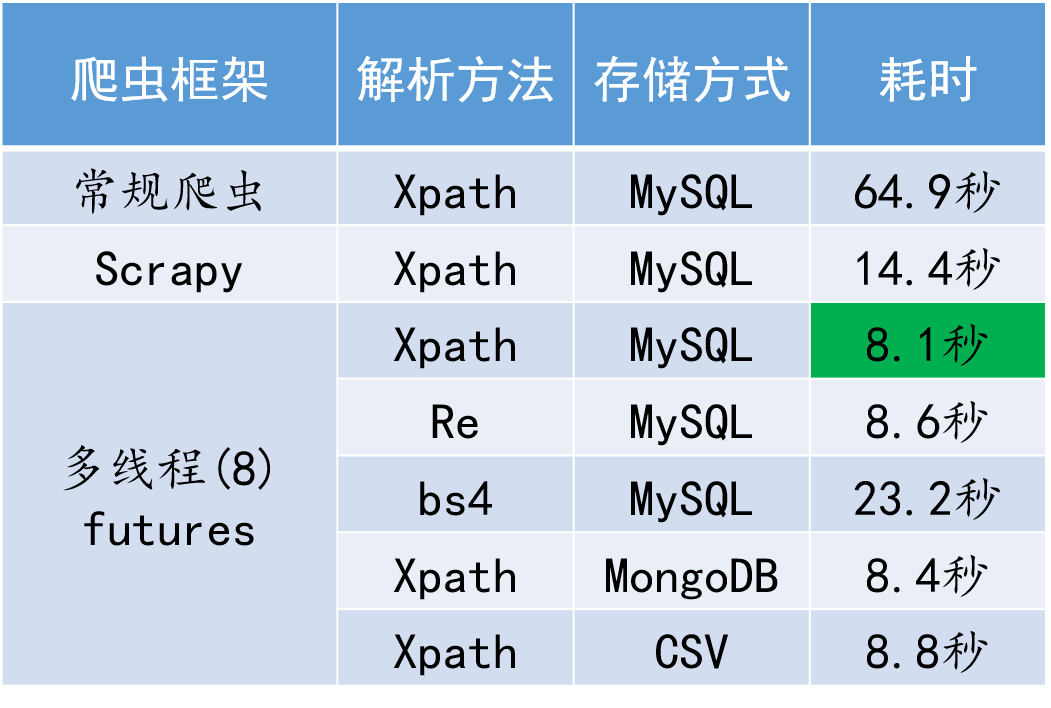概述
Python爬虫的方式有多种,从爬虫框架到解析提取,再到数据存储,各阶段都有不同的手段和类库支持。虽然不能一概而论哪种方式一定更好,毕竟不同案例需求和不同应用场景会综合决定采取哪种方式,但对比之下还是会有很大差距。

00 概况
以安居客杭州二手房信息为爬虫需求,分别对比实验了三种爬虫框架、三种字段解析方式和三种数据存储方式,旨在全方面对比各种爬虫方式的效率高低。
安居客平台没有太强的反爬措施,只要添加headers模拟头即可完美爬取,而且不用考虑爬虫过快的问题。选中杭州二手房之后,很容易发现url的变化规律。值得说明的是平台最大开放50页房源信息,每页60条。为使爬虫简单便于对比,我们只爬取房源列表页的概要信息,而不再进入房源详情页进行具体信息的爬取,共3000条记录,每条记录包括10个字段:标题,户型,面积,楼层,建筑年份,小区/地址,售卖标签,中介,单价,总价。
01 3种爬虫框架
1. 常规爬虫
实现3个函数,分别用于解析网页、存储信息,以及二者的联合调用。在主程序中,用一个常规的循环语句逐页解析。
import requests
from lxml import etree
import pymysql
import time
def get_info(url):
pass
return infos
def save_info(infos):
pass
def getANDsave(url):
pass
if __name__ == '__main__':
urls = [f'https://hangzhou.anjuke.com/sale/p{page}/' for page in range(1,51)]
start = time.time()
#常规单线程爬取
for url in urls:
getANDsave(url)
tt = time.time()-start
print("共用时:",tt, "秒。")
耗时64.9秒。
2. Scrapy框架
Scrapy框架是一个常用的爬虫框架,非常好用,只需要简单实现核心抓取和存储功能即可,而无需关注内部信息流转,而且框架自带多线程和异常处理能力。
class anjukeSpider(scrapy.Spider):
name = 'anjuke'
allowed_domains = ['anjuke.com']
start_urls = [f'https://hangzhou.anjuke.com/sale/p{page}/' for page in range(1, 51)]
def parse(self, response):
pass
yield item
耗时14.4秒。
3. 多线程爬虫
对于爬虫这种IO密集型任务来说,多线程可明显提升效率。实现多线程python的方式有多种,这里我们应用concurrent的futures模块,并设置最大线程数为8。
from concurrent.futures import ThreadPoolExecutor, wait, ALL_COMPLETED
def get_info(url):
pass
return infos
def save_info(infos):
pass
def getANDsave(url):
pass
if __name__ == '__main__':
urls = [f'https://hangzhou.anjuke.com/sale/p{page}/' for page in range(1,51)]
start = time.time()
executor = ThreadPoolExecutor(max_workers=8)
future_tasks = [executor.submit(getANDsave, url) for url in urls]
wait(future_tasks, return_when = ALL_COMPLETED)
tt = time.time()-start
print("共用时:",tt, "秒。")
耗时8.1秒。
对比来看,多线程爬虫方案耗时最短,相比常规爬虫而言能带来数倍的效率提升,Scrapy爬虫也取得了不俗的表现。需要指出的是,这里3种框架都采用了Xpath解析和MySQL存储。
02 3种解析方式
在明确爬虫框架的基础上,如何对字段进行解析提取就是第二个需要考虑的问题,常用的解析方式有3种,一般而言,论解析效率Re>=Xpath>Bs4;论难易程度,Bs4则最为简单易懂。
因为前面已经对比得知,多线程爬虫有着最好的执行效率,我们以此为基础,对比3种不同解析方式,解析函数分别为:
1. Xpath
from lxml import etreedef get_info(url):
response = requests.get(url, headers = headers)
html = response.text
html = etree.HTML(html)
items = html.xpath("//li[@class = 'list-item']")
infos = []
for item in items:
try:
title = item.xpath(".//div[@class='house-title']/a/text()")[0].strip()
houseType = item.xpath(".//div[@class='house-details']/div[2]/span[1]/text()")[0]
area = item.xpath(".//div[@class='house-details']/div[2]/span[2]/text()")[0]
floor = item.xpath(".//div[@class='house-details']/div[2]/span[3]/text()")[0]
buildYear = item.xpath(".//div[@class='house-details']/div[2]/span[4]/text()")[0]
adrres = item.xpath(".//div[@class='house-details']/div[3]/span[1]/text()")[0]
adrres = "|".join(adrres.split())
tags = item.xpath(".//div[@class='tags-bottom']//text()")
tags = '|'.join(tags).strip()
broker = item.xpath(".//div[@class='broker-item']/span[2]/text()")[0]
totalPrice = item.xpath(".//div[@class='pro-price']/span[1]//text()")
totalPrice = "".join(totalPrice).strip()
price = item.xpath(".//div[@class='pro-price']/span[2]/text()")[0]
values = (title, houseType, area, floor, buildYear, adrres, tags, broker, totalPrice, price)
infos.append(values)
except:
print('1条信息解析失败')
return infos
耗时8.1秒。
2. Re
import re
def get_info(url):
response = requests.get(url, headers = headers)
html = response.text
html = html.replace('n','')
pattern = r'<li class="list-item" data-from="">.*?</li>'
results = re.compile(pattern).findall(html)##先编译,再正则匹配
infos = []
for result in results:
values = ['']*10
titles = re.compile('title="(.*?)"').findall(result)
values[0] = titles[0]
values[5] = titles[1].replace(' ','')
spans = re.compile('<span>(.*?)</span><em class="spe-lines">|</em><span>(.*?)</span><em class="spe-lines">|</em><span>(.*?)</span><em class="spe-lines">|</em><span>(.*?)</span>').findall(result)
values[1] =''.join(spans[0])
values[2] = ''.join(spans[1])
values[3] = ''.join(spans[2])
values[4] = ''.join(spans[3])
values[7] = re.compile('<span class="broker-name broker-text">(.*?)</span>').findall(result)[0]
tagRE = re.compile('<span class="item-tags tag-others">(.*?)</span>').findall(result)
if tagRE:
values[6] = '|'.join(tagRE)
values[8] = re.compile('<span class="price-det"><strong>(.*?)</strong>万</span>').findall(result)[0]+'万'
values[9] = re.compile('<span class="unit-price">(.*?)</span>').findall(result)[0]
infos.append(tuple(values))
return infos
耗时8.6秒。
3. Bs4
from bs4 import BeautifulSoup
def get_info(url):
response = requests.get(url, headers = headers)
html = response.text
soup = BeautifulSoup(html, "html.parser")
items = soup.find_all('li', attrs={'class': "list-item"})
infos = []
for item in items:
try:
title = item.find('a', attrs={'class': "houseListTitle"}).get_text().strip()
details = item.find_all('div',attrs={'class': "details-item"})[0]
houseType = details.find_all('span')[0].get_text().strip()
area = details.find_all('span')[1].get_text().strip()
floor = details.find_all('span')[2].get_text().strip()
buildYear = details.find_all('span')[3].get_text().strip()
addres = item.find_all('div',attrs={'class': "details-item"})[1].get_text().replace(' ','').replace('n','')
tag_spans = item.find('div', attrs={'class':'tags-bottom'}).find_all('span')
tags = [span.get_text() for span in tag_spans]
tags = '|'.join(tags)
broker = item.find('span',attrs={'class':'broker-name broker-text'}).get_text().strip()
totalPrice = item.find('span',attrs={'class':'price-det'}).get_text()
price = item.find('span',attrs={'class':'unit-price'}).get_text()
values = (title, houseType, area, floor, buildYear, addres, tags, broker, totalPrice, price)
infos.append(values)
except:
print('1条信息解析失败')
return infos
耗时23.2秒。
Xpath和Re执行效率相当,Xpath甚至要略胜一筹,Bs4效率要明显低于前两者(此案例中,相当远前两者效率的1/3),但写起来则最为容易。
03 存储方式
在完成爬虫数据解析后,一般都要将数据进行本地存储,方便后续使用。小型数据量时可以选用本地文件存储,例如CSV、txt或者json文件;当数据量较大时,则一般需采用数据库存储,这里,我们分别选用关系型数据库的代表MySQL和文本型数据库的代表MongoDB加入对比。
1. MySQL
import pymysql
def save_info(infos):
#####infos为列表形式,其中列表中每个元素为一个元组,包含10个字段
db= pymysql.connect(host="localhost",user="root",password="123456",db="ajkhzesf")
sql_insert = 'insert into hzesfmulti8(title, houseType, area, floor, buildYear, adrres, tags, broker, totalPrice, price) values(%s,%s,%s,%s,%s,%s,%s,%s,%s,%s)'
cursor = db.cursor()
cursor.executemany(sql_insert, infos)
db.commit()
耗时8.1秒。
2. MongoDB
import pymongo
def save_info(infos):
# infos为列表形式,其中列表中的每个元素为一个字典,包括10个字段
client = pymongo.MongoClient()
collection = client.anjuke.hzesfmulti
collection.insert_many(infos)
client.close()
耗时8.4秒。
3. CSV文件
import csv
def save_info(infos):
# infos为列表形式,其中列表中的每个元素为一个列表,包括10个字段
with open(r"D:PyFileHZhouseanjuke.csv", 'a', encoding='gb18030', newline="") as f:
writer = csv.writer(f)
writer.writerows(infos)
耗时8.8秒。
可见,在爬虫框架和解析方式一致的前提下,不同存储方式间并不会带来太大效率上的差异。
04 结论

不同爬虫执行效率对比
易见,爬虫框架对耗时影响最大,甚至可带来数倍的效率提升;解析数据方式也会带来较大影响,而数据存储方式则不存在太大差异。
对此,个人认为可以这样理解:类似于把大象装冰箱需要3步,爬虫也需要3步:
网页源码爬取,
目标信息解析,
数据本地存储。
其中,爬取网页源码最为耗时,这不仅取决于你的爬虫框架和网络负载,还受限于目标网站的响应速度和反爬措施;信息解析其次,而数据存储则最为迅速,尤其是在磁盘读取速度飞快的今天,无论是简单的文件写入还是数据库存储,都不会带来太大的时间差异。
此为上篇。
下篇,我们将利用Pandas对爬取的房源信息进行数据分析和可视化。
每日留言
说说你最近遇到的有趣事情?
或者一句激励自己的话?
(字数不少于15字)
留言赠书
《Python网络爬虫开发》

2小时快速掌握Python基础知识要点。
完整Python基础知识要点
Python小知识 | 这些技能你不会?(一)
Python小知识 | 这些技能你不会?(二)
Python小知识 | 这些技能你不会?(三)
Python小知识 | 这些技能你不会?(四)
近期推荐阅读:
【1】整理了我开始分享学习笔记到现在超过250篇优质文章,涵盖数据分析、爬虫、机器学习等方面,别再说不知道该从哪开始,实战哪里找了
【2】【终篇】Pandas中文官方文档:基础用法6(含1-5)
觉得不错就点一下“在看”吧

最后
以上就是深情小虾米为你收集整理的多种爬虫方式对比的全部内容,希望文章能够帮你解决多种爬虫方式对比所遇到的程序开发问题。
如果觉得靠谱客网站的内容还不错,欢迎将靠谱客网站推荐给程序员好友。








发表评论 取消回复